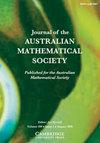半群、单群和群的自由积中的乘法表和词双曲性
IF 0.5
4区 数学
Q3 MATHEMATICS
引用次数: 1
摘要
本文研究了由Duncan和Gilman [' Word双曲半群',数学]定义的关于正则组合的具有上下文无关乘法表的词-双曲半群和单群的性质。剑桥哲人队。社会科学,2004,(3),513-524。特别考虑了在取免费产品的情况下,字双曲性的保持。在所涉及的半群的温和条件下,例如由半群或正则半群满足的半群,证明了两个字双曲半群的半群自由积又是字双曲的。同样地,在单位元表示的唯一性的一个温和条件下,例如,在群的条件下,我们证明了两个双曲一元群的单群自由积是双曲一元群。这些方法在语言理论上是通用的,并且同样适用于具有$\mathbf {C}$ -乘法表的半群、单群或群,其中$\mathbf {C}$是任何反向封闭的超级- $\operatorname {\ mathm {AFL}}$。特别地,我们推导出两个组对索引乘法表的自由积$\mathbf {ET0L}$对索引乘法表的自由积$\mathbf {ET0L}$。本文章由计算机程序翻译,如有差异,请以英文原文为准。
MULTIPLICATION TABLES AND WORD-HYPERBOLICITY IN FREE PRODUCTS OF SEMIGROUPS, MONOIDS AND GROUPS
This article studies the properties of word-hyperbolic semigroups and monoids, that is, those having context-free multiplication tables with respect to a regular combing, as defined by Duncan and Gilman [‘Word hyperbolic semigroups’, Math. Proc. Cambridge Philos. Soc.136(3) (2004), 513–524]. In particular, the preservation of word-hyperbolicity under taking free products is considered. Under mild conditions on the semigroups involved, satisfied, for example, by monoids or regular semigroups, we prove that the semigroup free product of two word-hyperbolic semigroups is again word-hyperbolic. Analogously, with a mild condition on the uniqueness of representation for the identity element, satisfied, for example, by groups, we prove that the monoid free product of two word-hyperbolic monoids is word-hyperbolic. The methods are language-theoretically general, and apply equally well to semigroups, monoids or groups with a
$\mathbf {C}$
-multiplication table, where
$\mathbf {C}$
is any reversal-closed super-
$\operatorname {\mathrm {AFL}}$
. In particular, we deduce that the free product of two groups with
$\mathbf {ET0L}$
with respect to indexed multiplication tables again has an
$\mathbf {ET0L}$
with respect to an indexed multiplication table.
求助全文
通过发布文献求助,成功后即可免费获取论文全文。
去求助
来源期刊
CiteScore
1.70
自引率
0.00%
发文量
36
审稿时长
6 months
期刊介绍:
The Journal of the Australian Mathematical Society is the oldest journal of the Society, and is well established in its coverage of all areas of pure mathematics and mathematical statistics. It seeks to publish original high-quality articles of moderate length that will attract wide interest. Papers are carefully reviewed, and those with good introductions explaining the meaning and value of the results are preferred.
Published Bi-monthly
Published for the Australian Mathematical Society

 求助内容:
求助内容: 应助结果提醒方式:
应助结果提醒方式:


